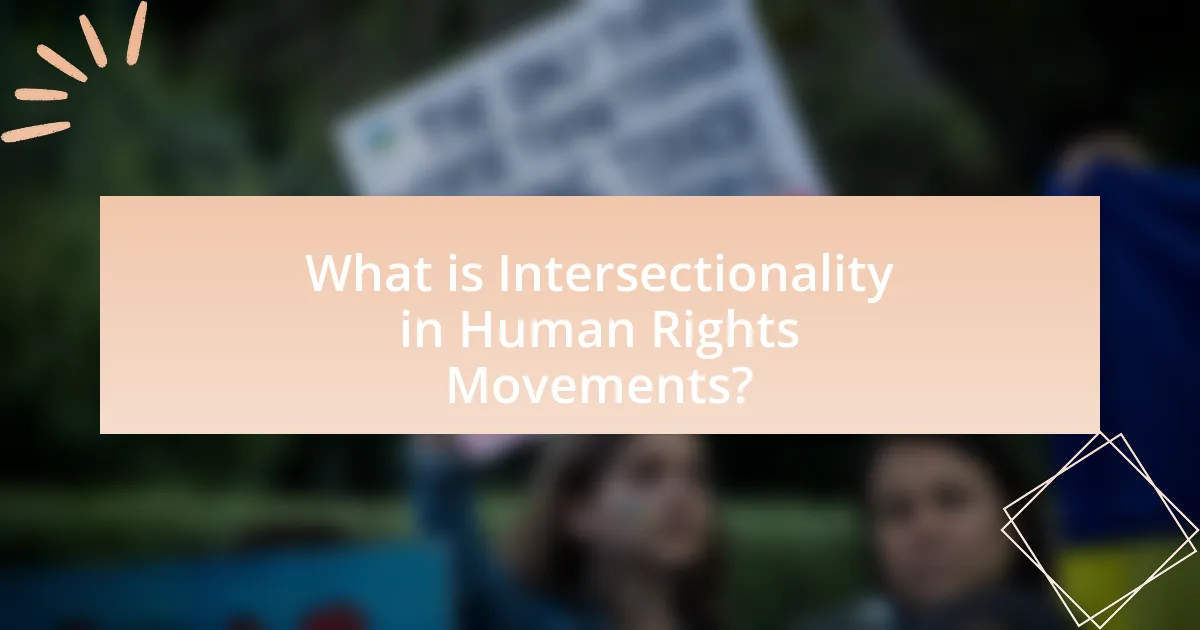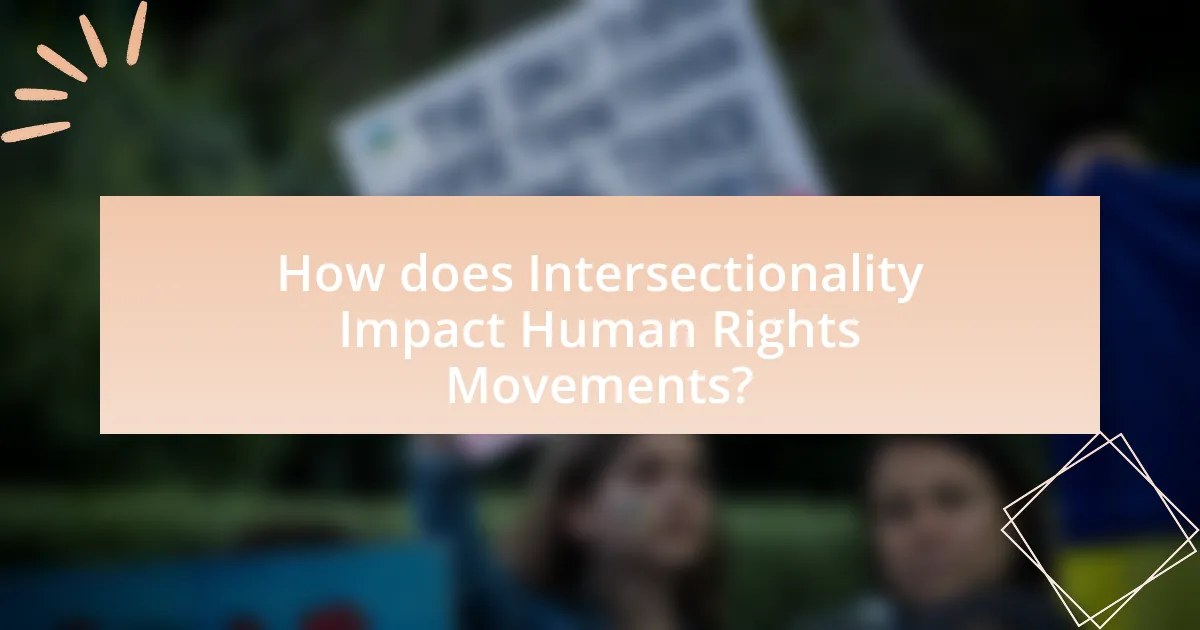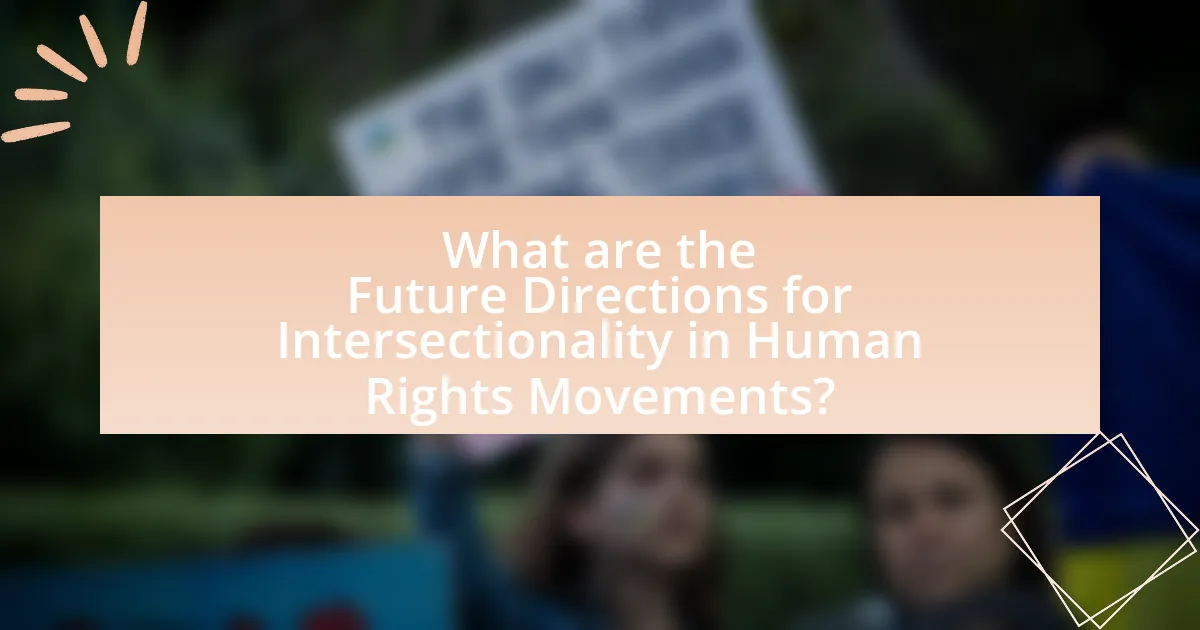Intersectionality in human rights movements is a framework that examines how overlapping social identities—such as race, gender, sexuality, and class—create unique experiences of discrimination and privilege. Introduced by Kimberlé Crenshaw in the late 1980s, this concept emphasizes the necessity of understanding the complexities of marginalized identities to effectively address human rights violations. The article explores the historical emergence of intersectionality, key figures associated with the framework, and its implications for advocacy and policy-making. It highlights the importance of incorporating intersectionality into human rights discourse to promote equity and justice for all individuals, while also addressing the limitations of traditional approaches that fail to consider the multifaceted nature of oppression.

What is Intersectionality in Human Rights Movements?
Intersectionality in human rights movements refers to the framework that examines how various social identities, such as race, gender, sexuality, and class, intersect to create unique modes of discrimination and privilege. This concept, introduced by Kimberlé Crenshaw in the late 1980s, highlights that individuals experience oppression in overlapping ways, which traditional human rights approaches may overlook. For instance, a Black woman may face both racial and gender discrimination simultaneously, necessitating a more nuanced understanding of her rights and needs. Research indicates that incorporating intersectionality into human rights advocacy leads to more effective strategies and policies that address the complexities of marginalized experiences, ultimately promoting equity and justice for all individuals.
How did the concept of intersectionality emerge in human rights discourse?
The concept of intersectionality emerged in human rights discourse primarily through the work of Kimberlé Crenshaw in the late 1980s, who introduced the term to address the overlapping and interdependent systems of discrimination faced by individuals with multiple marginalized identities. Crenshaw’s analysis highlighted how traditional frameworks of discrimination often failed to capture the unique experiences of Black women, illustrating that their struggles could not be understood solely through the lens of race or gender in isolation. This foundational work laid the groundwork for recognizing the complexity of social identities in human rights discussions, leading to a broader understanding of how various forms of oppression intersect and affect individuals differently. The incorporation of intersectionality into human rights discourse has since influenced policies and advocacy efforts, emphasizing the need for inclusive approaches that consider the diverse experiences of all individuals.
What historical events contributed to the development of intersectionality?
The development of intersectionality was significantly influenced by the civil rights movement of the 1960s, the feminist movement, and the emergence of critical race theory in the late 20th century. The civil rights movement highlighted the interconnectedness of race, class, and gender, as activists like Angela Davis emphasized the unique experiences of Black women. The feminist movement, particularly in its second wave, began to address the limitations of a predominantly white, middle-class perspective, leading to a broader understanding of women’s issues. Critical race theory, developed by scholars such as Kimberlé Crenshaw, explicitly articulated how overlapping social identities create distinct modes of discrimination, further solidifying the concept of intersectionality. These historical events collectively laid the groundwork for recognizing the complexity of social identities and their impact on individuals’ experiences of oppression and privilege.
Who are the key figures associated with the intersectionality framework?
Key figures associated with the intersectionality framework include Kimberlé Crenshaw, Patricia Hill Collins, and Angela Davis. Kimberlé Crenshaw, a legal scholar, coined the term “intersectionality” in 1989 to describe how various forms of social stratification, such as race, gender, and class, overlap. Patricia Hill Collins expanded on these ideas through her work on Black feminist thought, emphasizing the interconnectedness of social identities. Angela Davis, an activist and scholar, has contributed significantly to discussions on race, gender, and class, advocating for a holistic understanding of oppression. Their collective contributions have shaped the intersectionality framework, making it a vital tool in analyzing social justice issues.
Why is intersectionality crucial for understanding human rights?
Intersectionality is crucial for understanding human rights because it reveals how various social identities—such as race, gender, sexuality, and class—intersect to create unique experiences of discrimination and privilege. This framework allows for a more comprehensive analysis of human rights violations, as it acknowledges that individuals do not experience oppression in isolation but rather through a complex interplay of their identities. For instance, the United Nations’ 2018 report on the rights of women highlighted that women of color face compounded discrimination that is often overlooked in mainstream human rights discussions. By incorporating intersectionality, human rights advocates can better address the specific needs and challenges faced by marginalized groups, leading to more effective and inclusive policies.
How does intersectionality enhance the analysis of discrimination?
Intersectionality enhances the analysis of discrimination by providing a framework that recognizes how various social identities, such as race, gender, class, and sexuality, intersect to create unique experiences of oppression. This approach allows for a more nuanced understanding of how systemic inequalities operate, as it highlights that individuals may face multiple, overlapping forms of discrimination simultaneously. For example, a study by Crenshaw (1989) on Black women illustrates that their experiences cannot be fully understood by examining race or gender in isolation; instead, the intersection of both identities reveals specific vulnerabilities and challenges they face in society. By incorporating intersectionality into the analysis, researchers and activists can better identify and address the complexities of discrimination, leading to more effective advocacy and policy solutions.
What are the limitations of traditional human rights approaches without intersectionality?
Traditional human rights approaches without intersectionality fail to address the complexities of individual identities, leading to inadequate protection for marginalized groups. These approaches often overlook how overlapping social identities—such as race, gender, class, and sexuality—interact to create unique experiences of discrimination and oppression. For instance, a report by the United Nations highlights that women of color face distinct challenges that are not adequately addressed by a one-size-fits-all human rights framework. Consequently, traditional methods can perpetuate systemic inequalities by prioritizing the experiences of dominant groups while neglecting those of the most vulnerable, ultimately undermining the effectiveness of human rights advocacy.

How does Intersectionality Impact Human Rights Movements?
Intersectionality significantly impacts human rights movements by highlighting the interconnected nature of social categorizations such as race, gender, and class, which create overlapping systems of discrimination and disadvantage. This framework allows activists to address the unique experiences and challenges faced by individuals at the intersections of these identities, leading to more inclusive and effective advocacy. For instance, the 2015 report by the United Nations on the rights of women emphasized that policies must consider the diverse realities of women from different backgrounds to ensure equitable treatment and protection under human rights laws. By incorporating intersectionality, human rights movements can better identify and combat systemic inequalities, ultimately fostering a more just society.
What are the practical implications of applying intersectionality in advocacy?
Applying intersectionality in advocacy leads to more inclusive and effective strategies that address the diverse needs of marginalized communities. This approach recognizes that individuals experience overlapping identities, such as race, gender, sexuality, and class, which can compound discrimination and disadvantage. For instance, research by Crenshaw (1989) highlights how Black women face unique challenges that are not fully addressed by either feminist or anti-racist movements alone. By incorporating intersectionality, advocates can tailor their efforts to consider these complexities, resulting in policies and initiatives that better serve all affected groups. This inclusivity not only enhances the legitimacy of advocacy efforts but also fosters solidarity among various social justice movements, ultimately leading to more comprehensive human rights protections.
How can intersectionality inform policy-making in human rights?
Intersectionality can inform policy-making in human rights by ensuring that policies address the diverse and overlapping identities and experiences of individuals. This approach recognizes that individuals may face multiple forms of discrimination based on race, gender, sexuality, class, and other factors, which can compound their vulnerability. For instance, the United Nations has emphasized the importance of intersectionality in its human rights frameworks, highlighting that policies must be designed to consider these intersecting identities to effectively promote equality and justice. By incorporating intersectional analysis, policymakers can create more inclusive and effective human rights initiatives that better serve marginalized communities, ultimately leading to more equitable outcomes.
What strategies can activists use to incorporate intersectionality in their work?
Activists can incorporate intersectionality in their work by adopting inclusive frameworks that recognize and address the interconnected nature of social categorizations such as race, gender, class, and sexuality. This approach involves actively engaging with diverse communities to understand their unique experiences and challenges, ensuring that advocacy efforts reflect the complexities of individuals’ identities. For instance, the Women’s March has emphasized intersectionality by highlighting issues faced by women of color, LGBTQ+ individuals, and those from low-income backgrounds, demonstrating the necessity of a multifaceted approach in social justice movements. By utilizing intersectional analysis, activists can create more effective strategies that resonate with a broader audience and foster solidarity among various marginalized groups.
How does intersectionality affect marginalized communities within human rights movements?
Intersectionality significantly affects marginalized communities within human rights movements by highlighting the interconnected nature of social categorizations such as race, gender, sexuality, and class, which create overlapping systems of discrimination and disadvantage. This framework allows for a more nuanced understanding of how various forms of oppression interact, leading to unique experiences of marginalization that are often overlooked in traditional human rights advocacy. For instance, a study by Crenshaw (1989) introduced the term “intersectionality” to illustrate how Black women face discrimination that is distinct from that experienced by either Black men or white women, emphasizing the need for inclusive policies that address these specific challenges. By recognizing intersectionality, human rights movements can better advocate for comprehensive solutions that address the diverse needs of all marginalized groups, ultimately leading to more effective and equitable outcomes.
What unique challenges do intersectional identities face in human rights advocacy?
Intersectional identities face unique challenges in human rights advocacy due to the compounded discrimination they experience from multiple social categories, such as race, gender, sexual orientation, and socioeconomic status. This complexity often leads to a lack of representation and understanding within mainstream human rights movements, which may prioritize singular identity issues over the multifaceted nature of intersectional experiences. For instance, a study by Crenshaw (1989) highlighted how Black women face discrimination that is not fully addressed by either feminist or anti-racist movements, illustrating the necessity for advocacy that recognizes and addresses these overlapping identities. Consequently, intersectional advocates often struggle to gain visibility and support, making it difficult to effectively address their specific human rights needs.
How can intersectionality foster solidarity among diverse groups?
Intersectionality fosters solidarity among diverse groups by highlighting the interconnected nature of social identities and the unique challenges faced by individuals at the intersections of these identities. This framework encourages collaboration and understanding, as it reveals how various forms of discrimination, such as racism, sexism, and classism, overlap and compound, affecting marginalized communities differently. For instance, the experiences of a Black woman differ significantly from those of a white woman or a Black man, which underscores the necessity for inclusive advocacy that addresses these specific needs. By recognizing and validating these diverse experiences, intersectionality promotes empathy and collective action, enabling groups to unite in their struggles for justice and equality. This approach has been instrumental in movements like Black Lives Matter, which emphasizes the importance of addressing multiple forms of oppression to build a more inclusive and effective coalition for change.

What are the Future Directions for Intersectionality in Human Rights Movements?
Future directions for intersectionality in human rights movements include a greater emphasis on inclusive policy-making and the integration of diverse voices in advocacy efforts. This shift is driven by the recognition that human rights issues are interconnected and cannot be addressed in isolation. For instance, the 2021 UN report on the impact of COVID-19 highlighted how marginalized communities, including women of color and LGBTQ+ individuals, faced disproportionate challenges, underscoring the need for intersectional approaches. Additionally, organizations are increasingly adopting intersectional frameworks to address systemic inequalities, as seen in movements like Black Lives Matter, which advocate for racial justice while also addressing gender and economic disparities. This trend indicates a growing understanding that effective human rights advocacy must consider the multifaceted nature of identity and oppression.
How can intersectionality evolve to address emerging human rights issues?
Intersectionality can evolve to address emerging human rights issues by integrating diverse perspectives and experiences into policy-making and advocacy efforts. This evolution requires a systematic approach that recognizes the interconnectedness of various social identities, such as race, gender, sexuality, and socioeconomic status, which influence individuals’ experiences of discrimination and oppression. For instance, the rise of digital rights as a human rights issue necessitates an intersectional lens to understand how marginalized communities are disproportionately affected by surveillance and data privacy violations. Research by Crenshaw (1989) highlights that without considering these intersecting identities, policies may fail to protect the most vulnerable populations. Therefore, incorporating intersectionality into human rights frameworks can lead to more comprehensive and effective solutions that address the complexities of contemporary social justice challenges.
What role does technology play in advancing intersectional human rights advocacy?
Technology plays a crucial role in advancing intersectional human rights advocacy by enabling diverse voices to be heard and facilitating the dissemination of information. Digital platforms allow marginalized communities to share their experiences and mobilize support, which is essential for intersectional advocacy that addresses the unique challenges faced by individuals at the intersections of various identities. For instance, social media campaigns have successfully raised awareness about issues such as racial injustice, gender inequality, and LGBTQ+ rights, demonstrating the power of technology in amplifying these interconnected struggles. Furthermore, data analytics and online tools help organizations identify and address specific needs within different communities, ensuring that advocacy efforts are tailored and effective.
How can education systems integrate intersectionality into human rights curricula?
Education systems can integrate intersectionality into human rights curricula by incorporating diverse perspectives that reflect the experiences of marginalized groups. This can be achieved through the inclusion of case studies, literature, and historical accounts that highlight how various identities—such as race, gender, sexuality, and class—intersect to shape individuals’ experiences of oppression and privilege. For instance, the United Nations Educational, Scientific and Cultural Organization (UNESCO) emphasizes the importance of inclusive education that recognizes the complexities of identity in its guidelines for human rights education. By utilizing intersectional frameworks, curricula can foster critical thinking and empathy, enabling students to understand the multifaceted nature of human rights issues and advocate for social justice effectively.
What best practices can organizations adopt to promote intersectionality?
Organizations can promote intersectionality by implementing inclusive policies, fostering diverse leadership, and providing intersectionality training. Inclusive policies ensure that all marginalized groups are represented and considered in decision-making processes, which is essential for addressing the unique challenges faced by individuals at the intersection of multiple identities. Diverse leadership, which includes individuals from various backgrounds, enhances the organization’s ability to understand and advocate for the needs of different communities. Providing intersectionality training equips employees with the knowledge to recognize and address systemic inequalities, thereby fostering a more equitable environment. Research shows that organizations that prioritize intersectionality are more effective in creating inclusive spaces and driving social change, as highlighted in the report “Intersectionality Matters!” by the African American Policy Forum.
How can organizations measure the effectiveness of intersectional approaches?
Organizations can measure the effectiveness of intersectional approaches by utilizing quantitative and qualitative metrics that assess the impact on diverse groups. For instance, they can analyze demographic data to evaluate representation and participation rates of marginalized communities in programs and initiatives. Additionally, organizations can conduct surveys and focus groups to gather feedback on the experiences of individuals from various intersecting identities, thereby identifying areas of improvement. Research indicates that organizations employing intersectional frameworks often see enhanced engagement and satisfaction among participants, as evidenced by a study published in the Journal of Human Rights, which found that inclusive practices led to a 30% increase in community trust and participation.
What resources are available for activists to learn about intersectionality?
Activists can access various resources to learn about intersectionality, including books, online courses, and academic articles. Notable books such as “Intersectionality” by Kimberlé Crenshaw and “Sister Outsider” by Audre Lorde provide foundational knowledge on the subject. Online platforms like Coursera and edX offer courses on social justice and intersectionality, often featuring contributions from leading scholars. Additionally, academic journals such as “Signs: Journal of Women in Culture and Society” publish peer-reviewed articles that explore intersectional issues in depth. These resources collectively enhance understanding of how different social identities intersect and impact experiences of oppression and privilege.